JEE-Advanced-2020-Question-Paper-1 Code-E
PHYSICS
Section 1
• This Section contains Four (06) Questions.
• The answer to each question is a SINGLE DIGIT INTEGER ranging from 0 to 9
• For each question, enter the correct integer corresponding to the answer using the mouse and the on-screen virtual numeric keypad in the place designated to enter the answer.
• Answer to each question will be evaluated according to the following marking scheme:
Full Marks : +3 If ONLY the correct integer is entered;
Zero Marks : 0 If the question in unanswered;
Negative Marks : −1 In all other cases.
1. A large square container with thin transparent vertical walls and filled with water (refractive index 4/3) is kept on a horizontal table. A student holds a thin straight wire vertically inside the water 12 cm from one of its corners, as shown schematically in the figure. Looking at the wire from this corner, another student sees two images of the wire, located symmetrically on each side of the line of sight as shown. The separation (in cm) between these images is ____________.

2. A train with cross-sectional area St is moving with speed νt inside a long tunnel of cross-sectional area S0 (S0 = 4St). Assume that almost all the air (density ρ) in front of the train flows back between its sides and the walls of the tunnel. Also, the airflow with respect to the train is steady and laminar. Take the ambient pressure and that inside the train to be p0. If the pressure in the region between the sides of the train and the tunnel walls is p, then ![]() The value of N is ________.
The value of N is ________.
3. Two large circular discs separated by a distance of 0.01 m are connected to a battery via a switch as shown in the figure. Charged oil drops of density 900 kg m−3 are released through a tiny hole at the centre of the top disc. Once some oil drops achieve terminal velocity, the switch is closed to apply a voltage of 200 V across the discs. As a result, an oil drop of radius 8 × 10−7 m stops moving vertically and floats between the discs. The number of electrons present in this oil drop is ________. (neglect the buoyancy force, take acceleration due to gravity = 10 ms−2 and charge on an electron (e) = 1.6×10–19 C)

4. A hot air balloon is carrying some passengers, and a few sandbags of mass 1 kg each so that its total mass is 480 kg. Its effective volume giving the balloon its buoyancy is V. The balloon is floating at an equilibrium height of 100 m. When N number of sandbags are thrown out, the balloon rises to a new equilibrium height close to 150 m with its volume V remaining unchanged. If the variation of the density of air with height h from the ground is ![]() where ρ0 = 1.25 kg m−3 and h0 = 6000 m, the value of N is __________.
where ρ0 = 1.25 kg m−3 and h0 = 6000 m, the value of N is __________.
5. A point charge q of mass m is suspended vertically by a string of length l. A point dipole of dipole moment ![]() is now brought towards q from infinity so that the charge moves away. The final equilibrium position of the system including the direction of the dipole, the angles and distances is shown in the figure below. If the work done in bringing the dipole to this position is N × (mgh), where g is the acceleration due to gravity, then the value of N is _________ . (Note that for three coplanar forces keeping a point mass in equilibrium, F/sin θ is the same for all forces, where F is any one of the forces and θ is the angle between the other two forces)
is now brought towards q from infinity so that the charge moves away. The final equilibrium position of the system including the direction of the dipole, the angles and distances is shown in the figure below. If the work done in bringing the dipole to this position is N × (mgh), where g is the acceleration due to gravity, then the value of N is _________ . (Note that for three coplanar forces keeping a point mass in equilibrium, F/sin θ is the same for all forces, where F is any one of the forces and θ is the angle between the other two forces)

6. A thermally isolated cylindrical closed vessel of height 8 m is kept vertically. It is divided into two equal parts by a diathermic (perfect thermal conductor) frictionless partition of mass 8.3 kg. Thus the partition is held initially at a distance of 4 m from the top, as shown in the schematic figure below. Each of the two parts of the vessel contains 0.1 mole of an ideal gas at temperature 300 K. The partition is now released and moves without any gas leaking from one part of the vessel to the other. When equilibrium is reached, the distance of the partition from the top (in m) will be _______ (take the acceleration due to gravity = 10 ms−2 and the universal gas constant = 8.3 J mol−1K−1).
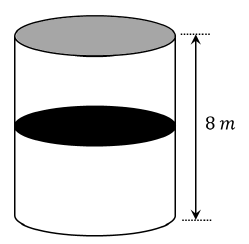
SECTION 2
• This section contains SIX (06) questions.
• Each question has FOUR options. ONE OR MORE THAN ONE of these four option(s) is (are) the correct answer(s).
• For each question, choose the option corresponding to the correct answer.
• Answer to each question will be evaluated according to the following marking scheme:
Full Marks : +4 If only (all) the correct option(s) is (are) chosen;
Partial Marks : +3 If all four options is correct but ONLY three options are chosen;
Partial Marks : +2 If there or more options are correct but ONLY two options are chosen; both of which are correct;
Partial Marks : +1 If two or more options are correct but ONLY one option is chosen and it is a correct option;
Zero Marks : 0 If none of the options is chosen (i.e. the questions is unanswered);
Negative Marks: −2 In all other cases.
7. A beaker of radius r is filled with water (refractive index 4/3) up to a height H as shown in the figure on the left. The beaker is kept on a horizontal table rotating with angular speed & omega;. This makes the water surface curved so that the difference in the height of water level at the centre and at the circumference of the beaker is h(h << H, h << r), as shown in the figure on the right. Take this surface to be approximately spherical with a radius of curvature R. Which of the following is/are correct? (g is the acceleration due to gravity)

(A) ![]()
(B) ![]()
(C) Apparent depth of the bottom of the beaker is close to 
(D) Apparent depth of the bottom of the beaker is close to 
8. A student skates up a ramp that makes an angle 30° with the horizontal. He/she starts (as shown in the figure) at the bottom of the ramp with speed 𝑣0 and wants to turn around over a semi-circular path xyz of radius R during which he/she reaches a maximum height h (at point y) from the ground as shown in the figure. Assume that the energy loss is negligible and the force required for this turn at the highest point is provided by his/her weight only. Then (g is the acceleration due to gravity)
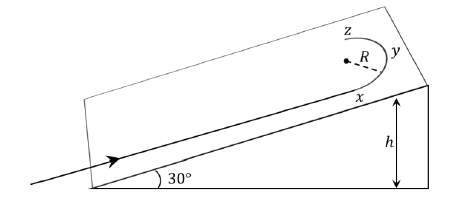
(A) ![]()
(B) ![]()
(C) the centripetal force required at points x and z is zero
(D) the centripetal force required is maximum at points x and z
9. A rod of mass m and length L, pivoted at one of its ends, is hanging vertically. A bullet of the same mass moving at speed v strikes the rod horizontally at a distance x from its pivoted end and gets embedded in it. The combined system now rotates with angular speed ω about the pivot. The maximum angular speed ωM is achieved for x = xM. Then

(A) ![]()
(B) ![]()
(C) ![]()
(D) ![]()
10. In an X-ray tube, electrons emitted from a filament (cathode) carrying current I hit a target (anode) at a distance d from the cathode. The target is kept at a potential V higher than the cathode resulting in the emission of continuous and characteristic X-rays. If the filament current𝐼 is decreased to 1/2, the d potential difference Vis increased to 2v, and the separation distance d is reduced to d/2, then
(A) the cut-off wavelength will reduce to half, and the wavelengths of the characteristic X-rays will remain the same
(B) the cut-off wavelength, as well as the wavelengths of the characteristic X-rays, will remain the same
(C) the cut-off wavelength will reduce to half, and the intensities of all the X-rays will decrease
(D) the cut-off wavelength will become two times larger, and the intensity of all the X-rays will decrease
11. Two identical non-conducting solid spheres of same mass and charge are suspended in the air from a common point by two non-conducting, massless strings of the same length. At equilibrium, the angle between the strings is α. The spheres are now immersed in a dielectric liquid of density 800 kg m−3 and dielectric constant 21. If the angle between the strings remains the same after the immersion, then
(A) electric force between the spheres remains unchanged
(B) electric force between the spheres reduces
(C) mass density of the spheres is 840 kg m−3
(D) the tension in the strings holding the spheres remains unchanged
12. Starting at time t = 0 from the origin with speed 1 ms−1, a particle follows a two-dimensional trajectory in the x-y plane so that its coordinates are related by the equation y = x2/2. The x and y components of its acceleration are denoted by ax and ay, respectively. Then
(A) ax = 1 ms−2 implies that when the particle is at the origin, ay = 1 ms−2
(B) ax = 0 implies ay = 1 ms−2 at all times
(C) at t = 0, the particle’s velocity points in the x-direction
(D) ax = 0 implies that at t = 1 s, the angle between the particle’s velocity and the x-axis is 45°
SECTION-3
• This section contains SIX (06) questions. The answer to each question is a NUMERICAL VALUE.
• For Each question, enter the correct numerical value of the answer using the mouse and the on-screen virtual numerical keypad in the place designated to enter the answer. If the numerical value has more than two decimal places. truncate/round-off the value to TWO decimal places.
• Answer to each question will be evaluated according to the following marking scheme:
Full marks : +4 If ONLY the correct numerical value is entered;
Zero Marks : 0 In all other cases.
13. A spherical bubble inside water has radius R. Take the pressure inside the bubble and the water pressure to be p0. The bubble now gets compressed radially in an adiabatic manner so that its radius becomes (R − a). For a << R the magnitude of the work done in the process is given by (4 πp0Ra2)X, where X is a constant and γ = Cp/CV = 41⁄30. The value of X is________.
14. In the balanced condition, the values of the resistances of the four arms of a Wheatstone bridge are shown in the figure below. The resistance R3 has temperature coefficient 0.0004℃−1. If the temperature of R3 is increased by 100℃, the voltage developed between S and T will be __________ volt.
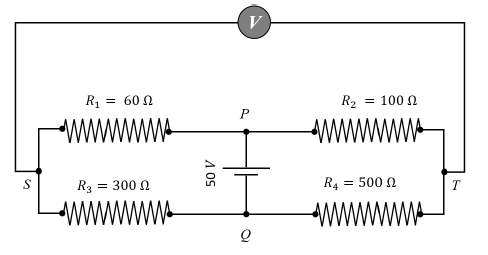
15. Two capacitors with capacitance values C1 = 2000 ± 10 pF and C2 = 3000 ± 15 pF are connected in series. The voltage applied across this combination is V = 5.00 ± 0.02 V. The percentage error in the calculation of the energy stored in this combination of capacitors is _______.
16. A cubical solid aluminium ![]() block has an edge length of 1m on the surface of the earth. It is kept on the floor of a 5 km deep ocean. Taking the average density of water and the acceleration due to gravity to be 103 kg m−3 and 10 ms−2, respectively, the change in the edge length of the block in mm is _____.
block has an edge length of 1m on the surface of the earth. It is kept on the floor of a 5 km deep ocean. Taking the average density of water and the acceleration due to gravity to be 103 kg m−3 and 10 ms−2, respectively, the change in the edge length of the block in mm is _____.
17. The inductors of two LR circuits are placed next to each other, as shown in the figure. The values of the self-inductance of the inductors, resistances, mutual-inductance and applied voltages are specified in the given circuit. After both the switches are closed simultaneously, then total work done by the batteries against the induced EMF in the inductors by the time the currents reach their steady-state values is ________ mJ.
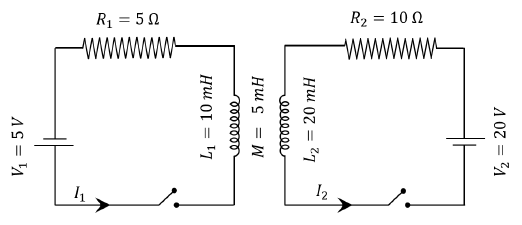
18. A container with 1 kg of water in it is kept in sunlight, which causes the water to get warmer than the surroundings. The average energy per unit time per unit area received due to the sunlight is 700 Wm−2 and it is absorbed by the water over an effective area of 0.05 m2. Assuming that the heat loss from the water to the surroundings is governed by Newton’s law of cooling, the difference (in ℃) in the temperature of water and the surroundings after a long time will be _____________. (Ignore the effect of the container, and take constant for Newton’s law of cooling = 0.001 s−1, the Heat capacity of water = 4200 J kg−1 K−1)
CHEMISTRY
Section 1
• This Section contains Four (06) Questions.
• The answer to each question is a SINGLE DIGIT INTEGER ranging from 0 to 9
• For each question, enter the correct integer corresponding to the answer using the mouse and the on-screen virtual numeric keypad in the place designated to enter the answer.
• Answer to each question will be evaluated according to the following marking scheme:
Full Marks : +3 If ONLY the correct integer is entered;
Zero Marks : 0 If the question in unanswered;
Negative Marks : −1 In all other cases.
1. The 1st, 2nd, and the 3rd ionization enthalpies, I1, I2, and I3, of four atoms with atomic numbers n, n + 1, n + 2, and n + 3, where n < 10, are tabulated below. What is the value of n?

2. Consider the following compounds in the liquid form:
O2, HF, H2O, NH3, H2O2, CCl4, CHCl3, C6H6, C6H5Cl.
When a charged comb is brought near their flowing stream, how many of them show deflection as per the following figure?

3. In the chemical reaction between stoichiometric quantities of KMnO4 and KI in weakly basic solution, what is the number of moles of I2 released for 4 moles of KMnO4 consumed?
4. An acidified solution of potassium chromate was layered with an equal volume of amyl alcohol. When it was shaken after the addition of 1 mL of 3% H2O2, a blue alcohol layer was obtained. The blue color is due to the formation of a chromium (VI) compound ‘X’. What is the number of oxygen atoms bonded to chromium through only single bonds in a molecule of X?
5. The structure of a peptide is given below.

If the absolute values of the net charge of the peptide at pH = 2, pH = 6, and pH = 11 are |z1|, |z2|, and |z3|, respectively, then what is |z1| + |z2| + |z3|?
6. An organic compound (C8H10O2) rotates plane-polarized light. It produces pink color with neutral FeCl3 What is the total number of all the possible isomers for this compound?
SECTION 2
• This section contains SIX (06) questions.
• Each question has FOUR options. ONE OR MORE THAN ONE of these four option(s) is (are) the correct answer(s).
• For each question, choose the option corresponding to the correct answer.
• Answer to each question will be evaluated according to the following marking scheme:
Full Marks : +4 If only (all) the correct option(s) is (are) chosen;
Partial Marks : +3 If all four options is correct but ONLY three options are chosen;
Partial Marks : +2 If there or more options are correct but ONLY two options are chosen; both of which are correct;
Partial Marks : +1 If two or more options are correct but ONLY one option is chosen and it is a correct option;
Zero Marks : 0 If none of the options is chosen (i.e. the questions is unanswered);
Negative Marks: −2 In all other cases.
7. In an experiment, m grams of a compound X (gas/liquid/solid) taken in a container is loaded in a balance as shown in figure I below. In the presence of a magnetic field, the pan with X is either deflected upwards (figure II), or deflected downwards (figure III), depending on the compound X. Identify the correct statement(s).
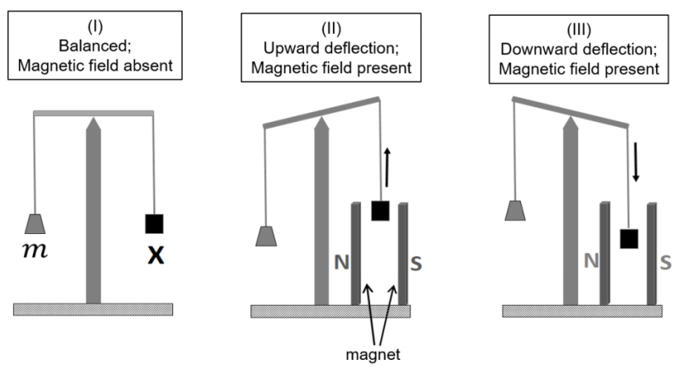
(A) If X is H2O(l), deflection of the panis upwards.
(B) If X is K4[Fe(CN)6](s), deflection of the panis upwards.
(C) If X is O2 (g), deflection of the panis downwards.
(D) If X is C6H6(l), deflection of the panis downwards.
8. Which of the following plots is (are) correct for the given reaction?
([P]0 is the initial concentration of P)
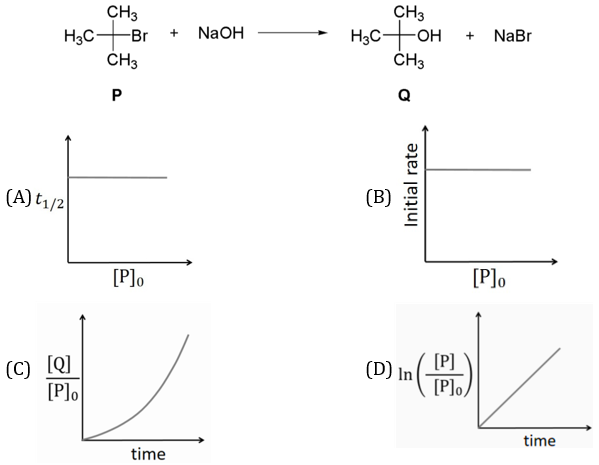
9. Which among the following statement(s) is(are) true for the extraction of aluminium from bauxite?
(A) Hydrated Al2O3 precipitates, when CO2 is bubbled through a solution of sodium aluminate.
(B) Addition of Na3AlF6 lowers the melting point of alumina.
(C) CO2 is evolved at the anode during electrolysis.
(D) The cathode is a steel vessel with a lining of carbon.
10. Choose the correct statement(s) among the following.
(A) SnCl2.2H2O is a reducing agent.
(B) SnO2 reacts with KOH to form K2[Sn(OH)6].
(C) A solution of PbCl2 in HCl contains Pb2+ and Cl− ions.
(D) The reaction of Pb3O4 with hot dilute nitric acid to give PbO2 is a redox reaction.
11. Consider the following four compounds I, II, III, and IV.

Choose the correct statement(s).
(A) The order of basicity is II >I >III >IV.
(B) The magnitude of pKb difference between I and II is more than that between III and IV.
(C) Resonance effect is more in III than in IV.
(D) Steric effect makes compound IV more basic than III.
12. Consider the following transformations of a compound P.
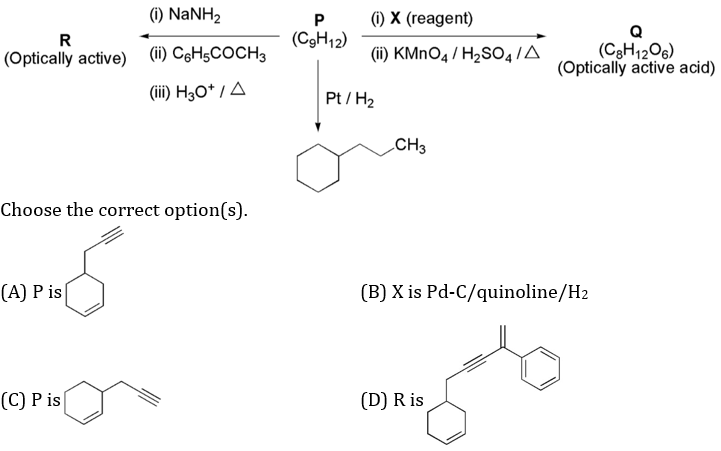
SECTION-3
• This section contains SIX (06) questions. The answer to each question is a NUMERICAL VALUE.
• For Each question, enter the correct numerical value of the answer using the mouse and the on-screen virtual numerical keypad in the place designated to enter the answer. If the numerical value has more than two decimal places. truncate/round-off the value to TWO decimal places.
• Answer to each question will be evaluated according to the following marking scheme:
Full marks : +4 If ONLY the correct numerical value is entered;
Zero Marks : 0 In all other cases.
13. A solution of 0.1 M weak base (B) is titrated with 0.1 M of a strong acid (HA). The variation of pH of the solution with the volume of HA added is shown in the figure below. What is the p𝐾b of the base? The neutralization reaction is given by B + HA → BH+ + A−.
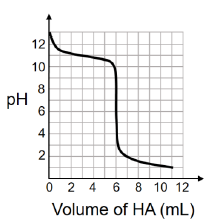
14. Liquids A and B form ideal solution for all compositions of A and B at 25℃. Two such solutions with 0.25 and 0.50 mole fractions of A have the total vapor pressures of 0.3 and 0.4 bar, respectively. What is the vapor pressure of pure liquid B in bar?
15. The figure below is the plot of potential energy versus internuclear distance (d) of H2 molecule in the electronic ground state. What is the value of the net potential energy E0 (as indicated in the figure) in kJ mol−1, for d = d0 at which the electron-electron repulsion and the nucleus-nucleus repulsion energies are absent? As reference, the potential energy of H atom is taken as zero when its electron and the nucleus are infinitely far apart.
Use Avogadro constant as 6.023 × 1023 mol−1.
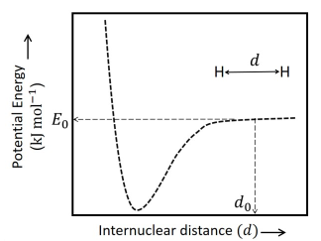
16. Consider the reaction sequence from P to Q shown below. The overall yield of the major product Q from P is 75%. What is the amount in grams of Q obtained from 9.3 mL of P? (Use density of P = 1.00 g mL−1; Molar mass of C = 12.0, H =1.0, O =16.0 and N = 14.0 g mol−1)

17. Tin is obtained from cassiterite by reduction with coke. Use the data given below to determine the minimum temperature (in K) at which the reduction of cassiterite by coke would take place.
At 298 K: ∆fH0 (SnO2(s)) = −581.0 kJ mol−1, ∆fH0(CO2(g)) = −394.0 kJ mol−1,
S0(SnO2(s)) = 56.0J K−1 mol−1, S0(Sn(s)) = 52.0 J K−1mol−1,
S0(C(𝑠)) = 6.0J K−1mol−1, S0(CO2(g)) = 210.0 J K−1mol−1.
Assume that the enthalpies and the entropies are temperature independent.
18. An acidified solution of 0.05 MZn2+ is saturated with 0.1 M H2 What is the minimum molar concentration (M) of H+ required to prevent the precipitation of ZnS?
Use Ksp(ZnS) = 1.25 x 10−22 and overall dissociation constant of H2S,
KNET = K1K2 = 1 × 10−21.
MATHEMATICS
Section 1
• This Section contains Four (06) Questions.
• The answer to each question is a SINGLE DIGIT INTEGER ranging from 0 to 9
• For each question, enter the correct integer corresponding to the answer using the mouse and the on-screen virtual numeric keypad in the place designated to enter the answer.
• Answer to each question will be evaluated according to the following marking scheme:
Full Marks : +3 If ONLY the correct integer is entered;
Zero Marks : 0 If the question in unanswered;
Negative Marks : −1 In all other cases.
1. For a complex number z, let Re(z) denote the real part of z. Let S be the set of all complex numbers z satisfying z4 − |z|4 = 4 iz2, where i = √(−1) . Then the minimum possible value of |z1 − z2|2, where z1, z2 ∈ S with Re(𝑧1) > 0 and Re(z2) < 0, is _____
2. The probability that a missile hits a target successfully is 0.75. In order to destroy the target completely, at least three successful hits are required. Then the minimum number of missiles that have to be fired so that the probability of completely destroying the target is NOT less than 0.95, is_____.
3. Let O be the centre of the circle x2 + y2 = r2, where r > √5/2 . Suppose PQ is a chord of this circle and the equation of the line passing through P and Q is 2x + 4𝑦 = 5. If the centre of the circumcircle of the triangle OPQ lies on the line 𝑥 + 2𝑦 = 4, then the value of r is_____
4. The trace of a square matrix is defined to be the sum of its diagonal entries. If A is a 2 × 2 matrix such that the trace of A is 3 and the trace of A3 is −18, then the value of the determinant of A is_____
5. Let the functions f: (−1,1) → R and g: (−1, 1) → (−1, 1) be defined by f(x) = |2x − 1| + |2x + 1|and g (x) = x − [x], where [x] denotes the greatest integer less than or equal to x. Let fog: (−1,1) → R be the composite function defined by (fog)(x) = f(g(x)). Suppose C is the number of points in the interval (−1, 1) at which fog is NOT continuous, and suppose d is the number of points in the interval (−1,1) at which fog is NOT differentiable. Then the value of c + d is _____
6. The value of the limit  is ______
is ______
SECTION 2
• This section contains SIX (06) questions.
• Each question has FOUR options. ONE OR MORE THAN ONE of these four option(s) is (are) the correct answer(s).
• For each question, choose the option corresponding to the correct answer.
• Answer to each question will be evaluated according to the following marking scheme:
Full Marks : +4 If only (all) the correct option(s) is (are) chosen;
Partial Marks : +3 If all four options is correct but ONLY three options are chosen;
Partial Marks : +2 If there or more options are correct but ONLY two options are chosen; both of which are correct;
Partial Marks : +1 If two or more options are correct but ONLY one option is chosen and it is a correct option;
Zero Marks : 0 If none of the options is chosen (i.e. the questions is unanswered);
Negative Marks: −2 In all other cases.
7. Let b be a nonzero real number. Suppose f = ℝ → ℝ is a differentiable function such that f(0) = 1. If the derivative f’ of f satisfies the equation ![]()
for all x ∈ ℝ, then which of the following statements is/are TRUE?
(A) If b > 0, then f is an increasing function
(B) If b < 0, then f is a decreasing function
(C) f(x) f(−x) = 1 for all x ∈ ℝ
(D) f(x) − f(− x) = 0 for all x ∈ ℝ
8. Let a and b be positive real numbers such that a > 1 and b < a. Let P be a point in the first quadrant that lies on the hyperbola  Suppose the tangent to the hyperbola at P passes through the point (1, 0), and suppose the normal to the hyperbola at P cuts off equal intercepts on the coordinate axes. Let Δ denote the area of the triangle formed by the tangent at P, the normal at P and the x-axis. If e denotes the eccentricity of the hyperbola, then which of the following statements is/are TRUE?
Suppose the tangent to the hyperbola at P passes through the point (1, 0), and suppose the normal to the hyperbola at P cuts off equal intercepts on the coordinate axes. Let Δ denote the area of the triangle formed by the tangent at P, the normal at P and the x-axis. If e denotes the eccentricity of the hyperbola, then which of the following statements is/are TRUE?
(A) 1 < e < √2
(B) √2 < e < 2
(C) ∆ = a4
(D) ∆ = b4
9. Let f: R → R and g: R → R be functions satisfying f(x + y) = f(x) + f(y) + f(x)f(y) and f(x) = xg(x)
For all x, y ∈ R. If ![]() then which of the following statements is/are TRUE?
then which of the following statements is/are TRUE?
(A) f is differentiable at every x ∈ R
(B) If g(0) = 1,then g is differentiable at every x ∈ R
(C) The derivative f′(1) is equal to 1
(D) The derivative f′(0) is equal to 1
10. Let α, β, γ, δ be real numbers such that α2 + β2 + γ2 ≠ 0 and α + γ = 1. Suppose the point (3, 2, −1) is the mirror image of the point (1, 0, −1) with respect to the plane αx + βy + γz = δ. Then which of the following statements is/are TRUE?
(A) α + β = 2
(B) δ − γ = 3
(C) δ + β = 4
(D) α + β + γ = δ
11. Let a and b be positive real numbers. Suppose ![]() are adjacent sides of a parallelogram PQRS. Let
are adjacent sides of a parallelogram PQRS. Let ![]() be the projection vectors of
be the projection vectors of ![]() If
If ![]() and if the area of parallelogram PQRS is 8, then which of the following statements is/are TRUE?
and if the area of parallelogram PQRS is 8, then which of the following statements is/are TRUE?
(A) a + b = 4
(B) a – b = 2
(C) The length of the diagonal PR of the parallelogram PQRS is 4
(D) ![]() is an angle bisector of the vectors
is an angle bisector of the vectors ![]()
12. For nonnegative integers s and r, let 
For positive integers m and n, let 
where for any nonnegative integer p, 
Then which of the following statements is/are TRUE?
(A) (m, n) = (n, m) for all positive integers m, n
(B) (m, n + 1) = (m + 1, n) for all positive integers m, n
(C) (2m, 2n) = 2 (m, n) for all positive integers m, n
(D) (2m, 2n) = ((m, n))2 for all positive integers m, n
SECTION-3
• This section contains SIX (06) questions. The answer to each question is a NUMERICAL VALUE.
• For Each question, enter the correct numerical value of the answer using the mouse and the on-screen virtual numerical keypad in the place designated to enter the answer. If the numerical value has more than two decimal places. truncate/round-off the value to TWO decimal places.
• Answer to each question will be evaluated according to the following marking scheme:
Full marks : +4 If ONLY the correct numerical value is entered;
Zero Marks : 0 In all other cases.
13. An engineer is required to visit a factory for exactly four days during the first 15 days of every month and it is mandatory that no two visits take place on consecutive days. Then the number of all possible ways in which such visits to the factory can be made by the engineer during 1-15 June 2021 is_____.
14. In a hotel, four rooms are available. Six persons are to be accommodated in these four rooms in such a way that each of these rooms contains at least one person and at most two persons. Then the number of all possible ways in which this can be done is_____.
15. Two fair dice, each with faces numbered 1, 2, 3, 4, 5 and 6, are rolled together and the sum of the numbers on the faces is observed. This process is repeated till the sum is either a prime number or a perfect square. Suppose the sum turns out to be a perfect square before it turns out to be a prime number. If p is the probability that this perfect square is an odd number, then the value of 14 p is _____
16. Let the function f: [0, 1] → R be defined by ![]()
Then the value of ![]() is______
is______
17. Let f:R → R be a differentiable function such that its derivative f’ is continuous and f(π) = − If F: [0, π ] → R is defined by ![]() and if
and if  then the value of f(0) is _______
then the value of f(0) is _______
18. Let the function f: (0, π) → R be defined by f(θ) = (sin θ + cos θ)2 + (sin θ − cos θ)4 . Suppose, the function f has a local minimum at θ precisely when θ ∈ {λ1 π, … , λr π}, where 0 < λ1 < ⋯ < λr < 1.Then the value of λ1 + ⋯ + λr is _____
Latest Govt Job & Exam Updates: